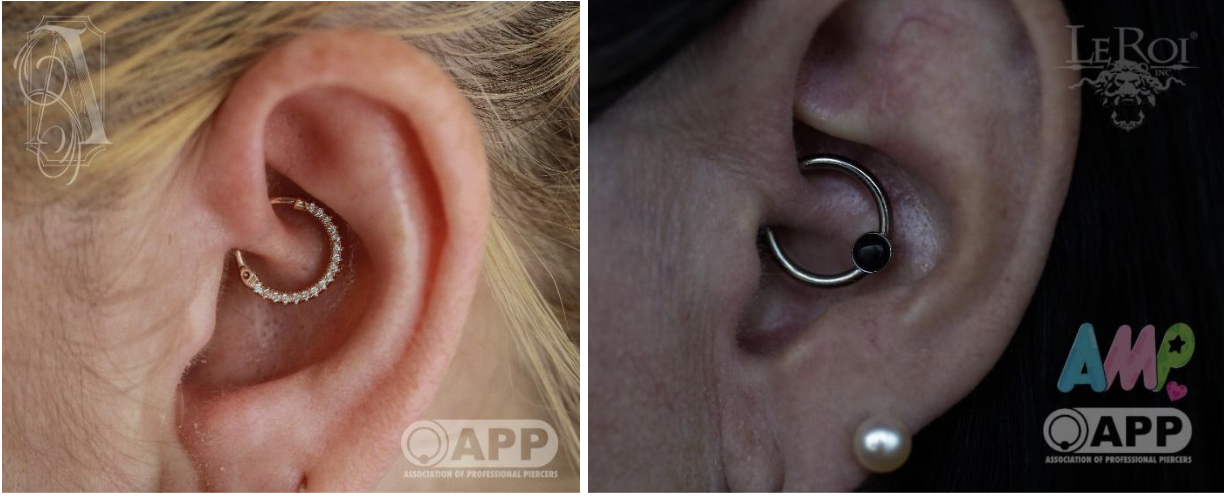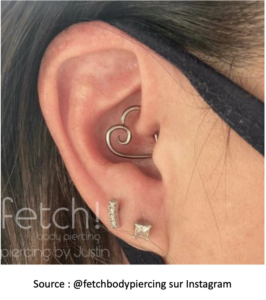Daith piercing: what there is to know
Daith piercing is a well-known piercing – it is gorgeous and it fills the ear cavity perfectly with decorative rings. It is gaining a lot of popularity, but it’s a piercing that is rather hard to heal, and even more so to pierce. There is a lot of misinformation regarding this piercing as well. In this article, we’ll talk about appropriate jewelry for the daith and we’ll debunk a few myths about it too.
Daith placement
While it is often mixed up with the rook piercing, the daith is located in the cavity of the ear, on a small, cartilaginous structure between the tragus and the forward helix. It’s a very narrow space, and it is not everyone who has that said structure. In lots of cases, it isn’t protruding enough to get the daith piercing. Only professional piercers that are familiar with different anatomies and placements should be able to perform this piercing. If it’s too shallow, it can reject. An incorrect angle may also play on the overall healing process.

Jewelry wise, what can we put in it?
For the initial piercing, the best option is a RING! Yes indeed, a ring! A captive bead ring, a circular barbell (horseshoe style), a decorative ring, as long a it’s a suitable quality as well as a proper diameter for an initial piercing, it can work for the healing process. The only style that is not suitable for a healing process is a continuous, seamless ring: the joints can cause irritation by constantly turning in the tunnel, specially in a healing piercing. Generally, a good piercer will go for a larger hoop, mostly in the beginning, to promote a great healing process.
A lot of piercers tend to put in a curved barbell, however, it should not be used for a fresh piercing. The curved barbell can turn on itself and the movement this cause can only irritate the piercing and harm the healing process. It can also turn inwards, facing your ear canal, and the area being narrow enough as it is, can be really hard to place it back properly. Once properly healed, it is a jewelry style that can be worn in a daith, however, it won’t prevent the jewelry from moving all around and causing a discomfort.
Heart shaped jewelry are also popular for this piercing, however it should only be worn in a fully healed daith piercing as the V part of the heart may end up in the tunnel and cause an immense pressure and irritation.

What about migraines?
We were talking about misinformation earlier – if you had the idea of getting your daith pierced to help with your migraines, you may want to reconsider it. There is currently no study that can prove or demonstrate the daith piercing can help with chronic migraines. It is not a magical acupuncture spot that helps alleviate the symptoms either. It is only the placebo effect working its magic. It’s such a popular myth that people are convinced this piercing will help with their troubles. Thoughts are strong, so the placebo effect is working on full gear once the piercing is done.
Fun fact
The daith piercing was first performed by Erik Dakota on his client named Theresa. She wanted something unique. After doing this piercing for the first time, he asked her to name that said piercing. That client was of the catholic faith and she was also learning Hebrew at the time. Theresa then decided to name it daith, which comes from the word daath or da’at, meaning knowledge and intelligence in that language. The actual pronunciation of this word is doth, which rhymes with goth. However, some people pronounce daith, which rhymes with faith, for the way it’s spelled.
Source : https://www.lynnloheide.com/post/daith-piercings-101